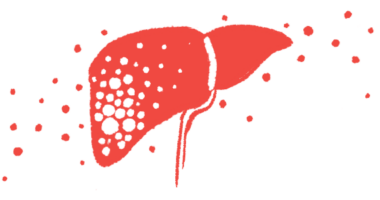Kaftrio reduces liver fibrosis in CF children: Real-world study
Up to 15% of cystic fibrosis patients develop CF-related liver disease

At least three months of Kaftrio treatment reduced liver stiffness, an indicator of liver fibrosis, in school-age children and adolescents with cystic fibrosis (CF), according to a real-world study in Sweden.
The benefits were particularly prominent among children who had signs of CF-related liver disease (CFLD) before starting Kaftrio, which is sold as Trikafta in the U.S.
“[Kaftrio] treatment could positively affect [CFLD] in children with CF, as demonstrated by reduced liver stiffness during treatment,” the researchers wrote.
The study, “The effect of elexacaftor-tezacaftor-ivacaftor on liver stiffness in children with cystic fibrosis,” was published in the Journal of Pediatric Gastroenterology and Nutrition.
In CF, genetic mutations disrupt production of CFTR protein
In CF, inherited genetic mutations disrupt the production and/or function of the CFTR protein. This leads to the buildup of abnormally thick and sticky mucus, particularly in the lungs and digestive system, including the liver.
Up to 15% of CF patients, most commonly children, will develop CFLD. Signs may include jaundice, characterized by a yellowing of the skin and whites of the eyes, itching, and an enlarged liver or spleen. Over time, scarring, known as fibrosis, can develop, resulting in cirrhosis, which is marked by irreversible scar formation that can affect liver function and lead to liver failure.
Kaftrio is a CFTR modulator designed to correct the faulty CFTR protein. It has been shown to be highly effective at improving patients’ lung function and extending survival.
One of the most common side effects of CFTR modulators is an elevation of liver enzymes, a sign of liver injury. The effect of these therapies on CFLD and liver stiffness, an indicator of liver fibrosis, remains unclear.
Study involves 21 Swedish children, adolescents
To address these unknowns, a research team in Sweden examined the medical records of 21 children and adolescents with CF who started Kaftrio treatment and had undergone screening for liver disease. Liver stiffness was assessed before and after Kaftrio treatment using elastography, a noninvasive imaging tool.
All of the study group, about half of whom were female patients, had pancreatic insufficiency, which is characterized by the insufficient supply of pancreatic enzymes needed for digestion.
A dozen patients (57%) had signs of liver disease in the months before starting Kaftrio, as indicated by abdominal ultrasound, persistent elevation of liver enzymes, elevated liver stiffness, or liver biopsy results. Still, there were no signs of advanced CFLD, which includes advanced scarring and/or portal hypertension (high blood pressure in the major vein that carries blood from the digestive organs to the liver).
One-third of the children were receiving ursodeoxycholic acid, a liver disease treatment. Before Kaftrio treatment, more than half (57%) had been treated with the CFTR modulator Orkambi (ivacaftor/lumacaftor).
Treatment with [Orkambi] did not show the same beneficial effect on liver stiffness as did [Kaftrio] treatment.
Across all patients, liver stiffness was significantly reduced at least three months after starting Kaftrio. Patients with liver disease before Kaftrio primarily drove these findings. Their decline in liver stiffness was statistically significant compared with those without liver disease, who showed a minor decrease.
Among the 12 children who had received Orkambi, liver stiffness significantly increased between two and four years before Kaftrio, but didn’t change until they started Kaftrio.
“Treatment with [Orkambi] did not show the same beneficial effect on liver stiffness as did [Kaftrio] treatment,” the researchers noted.
In terms of liver enzymes overall, there was a significant reduction in aspartate aminotransferase (AST) after starting Kaftrio. There was also a slight increase in gamma-glutamyl transferase (GGT) levels. Even so, AST and GGT levels remained within the normal range.
Patients with liver disease before Kaftrio had significantly elevated AST levels, which significantly improved with Kaftrio, the researchers noted. No changes were observed in the levels of GGT and alanine aminotransferase (ALT), and there were no differences between those with and without pre-Kaftrio liver disease.
Although no changes in liver enzymes were observed before and after Orkambi treatment, there was a significant reduction among these 12 patients in AST and ALT after starting Kaftrio, as well as a significant increase in GGT.
The researchers noted that Kaftrio resulted in a clear improvement in lung function across all patients.
“This study shows a positive effect on liver stiffness and improvements in lung function in [school-age children with CF] after at least 3 months of [Kaftrio] treatment,” the researchers wrote. “Further longitudinal studies on [CFLD] during [Kaftrio] treatment are needed to investigate its long-term effects.”








